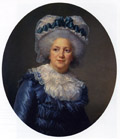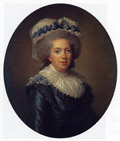 June 5 - August 8, 1982

|
|
| |||||||||
Oil on canvas, oval 30 1/8 x 25 1/2 inches (77 x 65 cm.) Signed and dated lower right: E. Vigee Le Brun / d Rome 1791 Phoenix Art Museum, Purchased through a Gift Fund, 1974, by an Anonymous Donor in Memory of Mr. Donald D. Harrington Louise Marie Therese Victoire de France (1733-1799), the seventh child of Louis XV and his Polish consort, Marie Leczynska, was born at Versailles. At the age of five she was sent off to the convent abbey of Fontevrault near Saumur and was allowed to return to her family only ten years later. Like all but one of the seven royal daughters, Madame Victoire never married. (Daughters of the Kings of France traditionally bore the title "Madame" even when they were unmarried.) A gifted musician, she participated in the musical salon organized in the early 1760s by her older and more domineering sister Adelaide. The seven-year-old Mozart performed at the same salon, and he dedicated a sonata to Victoire. She was perhaps the best natured of Louis
"Mesdames Tantes," as they were known, returned to Versailles at the outbreak of the Revolution. Along with Louis XVI and his family, they were escorted towards Paris by the mobs that invested the palace on the night of October 5-6, 1789. In 1791, as soon as the King had approved the civil constitution of the clergy, his aunts petitioned him for permission to leave the realm. En route for Italy, their coaches were stopped repeatedly and their persons threatened, but they finally managed to cross into Piedmont. Their reception was triumphal all along the way to Rome, where they were to live until 1796. In the wake of the French invasion of Italy, the two elderly spinsters fled first to Albano and then to Naples. In February 1797, they were lodged by Ferdinando IV at Caserta. Having long since depleted their financial resources, they were reduced to borrowing in order to keep their household together. In 1799, the arrival of the French troops obliged them to flee once again, this time to Trieste where they died, Victoire on June 7, 1799, and Adelaide on February 18, 1800. Their remains were returned to France in 1817 and were given a final resting place in the basilica of Saint Denis. Although they had never patronized her in France, in Rome "Mesdames Tantes" eagerly sought out the steadfastly royalist Mme Le Brun. They were all too aware that their own court painter had embraced the ideology of the new order, and by the time they left Paris their relations with her had become strained and bitter (see A.-M. Passez, Adelaide Labille-Guiard, Paris, 1973, pp. 34-35). It was with obvious relish that Vigee Le Brun recorded in her memoirs: "Several of the portraits that I painted ... during my stay in Rome afforded me great satisfactions; among them that of seeing once again Mesdames de France, the aunts of Louis XVI, who as soon as they arrived summoned me and asked me to paint them. I was not unaware that a certain woman artist [Labille Guiard], who always expressed animosity towards me - I know not why - had tried in every imaginable way to sully me in the eyes of the Princesses. But the extreme kindness with which they treated me reassured me that her vile calumnies had produced no effect on them. First I painted the portrait of Madame Adelaide, then, that of Madame Victoire" (Souvenirs, 111, 143-144.) Vigee Le Brun's portraits of "Mesdames" were executed in Rome while the two sisters were residing in the Palazzo di Carolis as guests of the French ambassador to the Vatican, Cardinal de Bernis. The sittings were coincident with the royal family's hapless flight from Paris, which occurred on June 20, 1791. On the day of the last posing session, the naive Victoire announced to the artist that Louis XVI had succeeded in escaping and that she had written him addressing the letter simply "To His Majesty the King of France." The following day the tragic news of the family's arrest at Varennes reached Rome. On July 13, Girodet, the young pro-revolutionary prix de Rome, noted ironically in a letter to his fellow pupil Franqois Gerard: "The day of the big news [that of Louis XVI's flight] the portraits of Mesdames were sketched onto canvas with the corners of their mouths turned up in a smile. If they are finished, they will have to be shown drooping." (Lettres adressees au baron Frangois Gerard, Paris, 1886, I, 179.) Phoenix's painting has invariably been exhibited as the portrait of Madame Adelaide, but that work (fig. 36), also signed and dated 1791, is in the Musee Jeanne d'Abboville, La Fere (Aisne). A portrait of Madame Victoire attributed to Vigee Le Brun was in the Tarade collection when exhibited in 1875 at Blois, Exposition retrospective au Chdteau de Blois, no. 340. PROVENANCE: Marquis Francois de Ganay, by 1910; Comtesse de Behague; Wildenstein, New York; purchased in 1974 by the Phoenix Art Museum with a gift fund by an anonymous donor in memory of Mr. Donald D. Harrington. MAJOR EXHIBITIONS: Berlin, Konigliche Akademie der Kiinste, Exposition d'oeuvres de I'art francais au XVIIIE siecle, January 26-March 6, 1910, no. 81, illus.; New York, Wildenstein, French XVIlIth Century Paintings, 1948, no. 51, illus. REFERENCES: Souvenirs, II, 143-144, 368; C. Strienski, Mesdames de France, Paris, 1911, p. 210.
|
|
Kimbell Art Museum, Fort Worth, Texas.
Web Site Designed and Maintained by |

